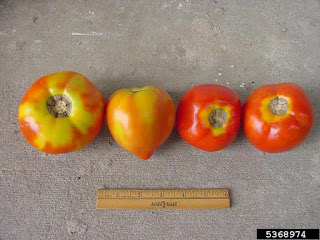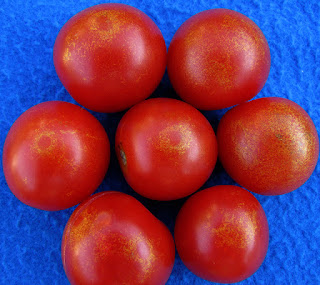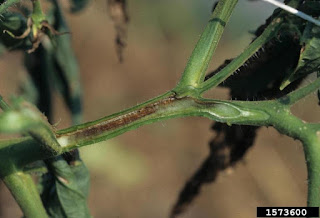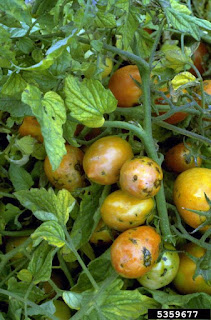Authors: Marissa Schuh and Natalie Hoidal. Portions of this article were originally published in a 2023 weekly vegetable update.
We are entering peak tomato, and markets are flooded with beautiful tomatoes. However, not every tomato we grow is market-ready, read on for tips for diagnosing and managing common tomato fruit issues.
Issues caused by tomato physiology
Catfacing causes brown scabbing on fruit
Catfacing is what we call it when the blossom end scar becomes enlarged and causes growth deformities. Catfacing is not well understood, but researchers think that it can happen when there are cold temperatures during flowering, or significant fluctuations in daily high and low temps. Thrips, high social nitrogen, and especially variety can also play a role.
Growth cracks can occurs both horizontally and laterally on fruit
Growth growth cracks occur when we get large flushes of water. Cracks can be large or small, horizontal or vertical. Tiny growth cracks around the stem end of tomato fruit can happen with fluctuating water levels. Specifically this is most common when there is a flush of moisture following a dry period. Larger cracks create openings for secondary pathogens or even insects to enter the fruit, while smaller, more subtle cracking may not impact marketability depending on your markets. Variety plays a role, as different varieties have different skin elasticity.

Fruit with yellow shoulder have yellow, hard areas near the stem

Yellow shoulders is when the stem end of the fruit remains yellow and hard. When cut in half, yellow areas may appear white, and the affected portion of the fruit never ripen.
Issues caused by insects
Stinkbugs causes discrete, ghostly spots
The last month has seen the hatching of brown marmorated stink bug (in addition to all the species of stink bug that have been in Minnesota for a while). Stinkbug feeding appears as pale (in green tomatoes) to yellow (in red tomatoes) spots on the surface of the fruit. If you cut the tomato and bisect the spots, if stink bugs did the feeding, the area around the spot will be white. The discoloration and unripened areas surrounding the feeding are the results of stinkbugs feeding with their straw like mouthpart.

Thrips cause bursts of yellow speckles
Thrips are small, yellow oblong insects with a mouthpart that is a little similar to stink bugs. Instead of being a straightforward straw, thrips mouthparts have that piece but also scrape (rasp is the entomological term). This feeding causes golden flecks. These are often in a circular pattern that mirrors where tomato fruits were touching each other on the plant (thrips hang out in protected areas).

Big takeaways
We are entering peak tomato, and markets are flooded with beautiful tomatoes. However, not every tomato we grow is market-ready, read on for tips for diagnosing and managing common tomato fruit issues.
Issues caused by tomato physiology
Catfacing causes brown scabbing on fruit
Catfacing is what we call it when the blossom end scar becomes enlarged and causes growth deformities. Catfacing is not well understood, but researchers think that it can happen when there are cold temperatures during flowering, or significant fluctuations in daily high and low temps. Thrips, high social nitrogen, and especially variety can also play a role.
Catfacing. Gerald Holmes, Strawberry Center, Cal Poly San Luis Obispo, Bugwood.org
Growth cracks can occurs both horizontally and laterally on fruit
Growth growth cracks occur when we get large flushes of water. Cracks can be large or small, horizontal or vertical. Tiny growth cracks around the stem end of tomato fruit can happen with fluctuating water levels. Specifically this is most common when there is a flush of moisture following a dry period. Larger cracks create openings for secondary pathogens or even insects to enter the fruit, while smaller, more subtle cracking may not impact marketability depending on your markets. Variety plays a role, as different varieties have different skin elasticity.
Mild growth cracks, sometimes called rain check. Photo: Natalie Hoidal
Tomatoes showing different severity of yellow shoulder. Photo: Paul Bachi, University of Kentucky Research and Education Center, Bugwood.org
Yellow shoulders is when the stem end of the fruit remains yellow and hard. When cut in half, yellow areas may appear white, and the affected portion of the fruit never ripen.
Yellow shoulder is poorly understood, but may stem from very hot weather, potassium deficiency, or direct sun exposure. Variety also plays a role.
However, we also see it when tomato plants have pathogens that cause the stems to become cankerous since dead stem tissue isn’t able to efficiently transport nutrients. In particular, we’ve noticed yellow shoulder co-occurring with bacterial canker, which has been spreading across Minnesota in recent years. If you look up this pathogen you’ll see dramatic lesions on fruit, but in our anecdotal experience, it typically has to get really bad before you start to see fruit lesions. We typically first notice yellow shoulder and leaf symptoms when this pathogen first shows up on a farm. If you’re seeing a lot of yellow shoulder, take a step back and investigate your plants for signs of disease on the leaves, stems, and roots.

However, we also see it when tomato plants have pathogens that cause the stems to become cankerous since dead stem tissue isn’t able to efficiently transport nutrients. In particular, we’ve noticed yellow shoulder co-occurring with bacterial canker, which has been spreading across Minnesota in recent years. If you look up this pathogen you’ll see dramatic lesions on fruit, but in our anecdotal experience, it typically has to get really bad before you start to see fruit lesions. We typically first notice yellow shoulder and leaf symptoms when this pathogen first shows up on a farm. If you’re seeing a lot of yellow shoulder, take a step back and investigate your plants for signs of disease on the leaves, stems, and roots.
Discoloration in tomato vascular tissue caused by bacterial canker. Photo: Gerald Holmes, Strawberry Center, Cal Poly San Luis Obispo, Bugwood.org
Issues caused by pathogensViruses causes a range of spots
Viruses causes odd spots and bumps on tomato fruit, as well as on the leaves. These spots can vary in color and appearance depending on the virus, from firm, dark colored spots to perfectly circular dots to tie-dye-esque streaks and stripes. Insects move these pathogens around, which can happen with even low insects populations and a bit of bad luck. If you are seeing lots of virus incidence, check in on insect management during transplant production -- it is easy for an infected insect to infect whole trays in a greenhouse transplant production.

Anthracnose causes circular depressions
One of the most common tomato fruit issues we see in Minnesota is anthracnose. This disease starts as a circular depression in ripe tomato fruit – almost as if someone pressed their thumb into the soft flesh. The disease progresses, the infected area will turn black at the center, and if there is moisture, you may see pink spores. This pathogen can infect tomato fruit on plants where the foliage is totally healthy. Sometimes farmers see a lot of this disease when they are waiting a little too long to harvest, so picking at the blush stage or when fruit are first ripe can help.
Early blight causes black, leathery areas on fruit
Early blight lesions are a common find on the lower leaves of tomato plants across the state. While this disease is typically a slow plant killer, it can occasionally make the leap into tomato fruit. When it does this, the disease presents a black leathery areas that start on the stem end of the plant. If you look closely at these spots, you may see the same concentric rings that you see on infected leaves. The closer we get to the end of the season, the more incidences of this pathogen we see.
Viruses causes odd spots and bumps on tomato fruit, as well as on the leaves. These spots can vary in color and appearance depending on the virus, from firm, dark colored spots to perfectly circular dots to tie-dye-esque streaks and stripes. Insects move these pathogens around, which can happen with even low insects populations and a bit of bad luck. If you are seeing lots of virus incidence, check in on insect management during transplant production -- it is easy for an infected insect to infect whole trays in a greenhouse transplant production.
Tomato fruit showing tomato spotted wilt virus symptoms. William M. Brown Jr., Bugwood.org
Anthracnose causes circular depressions
Discrete, circular spots caused by anthracnose. Photo: UMN.
Early blight causes black, leathery areas on fruit
Early blight lesions are a common find on the lower leaves of tomato plants across the state. While this disease is typically a slow plant killer, it can occasionally make the leap into tomato fruit. When it does this, the disease presents a black leathery areas that start on the stem end of the plant. If you look closely at these spots, you may see the same concentric rings that you see on infected leaves. The closer we get to the end of the season, the more incidences of this pathogen we see.
Early blight on tomato fruit. Photo: UMN.
Stinkbugs causes discrete, ghostly spots
The last month has seen the hatching of brown marmorated stink bug (in addition to all the species of stink bug that have been in Minnesota for a while). Stinkbug feeding appears as pale (in green tomatoes) to yellow (in red tomatoes) spots on the surface of the fruit. If you cut the tomato and bisect the spots, if stink bugs did the feeding, the area around the spot will be white. The discoloration and unripened areas surrounding the feeding are the results of stinkbugs feeding with their straw like mouthpart.
A discrete spot of stinkbug feeding. Gerald Holmes, Strawberry Center, Cal Poly San Luis Obispo, Bugwood.org
Thrips are small, yellow oblong insects with a mouthpart that is a little similar to stink bugs. Instead of being a straightforward straw, thrips mouthparts have that piece but also scrape (rasp is the entomological term). This feeding causes golden flecks. These are often in a circular pattern that mirrors where tomato fruits were touching each other on the plant (thrips hang out in protected areas).
Thrips feeding on tomato. Photo: Cornell University Long Island Horticultural Research & Extension Center
Big takeaways
- Note which varieties have which problems and do small, on-farm trials to find suitable replacements. The Cornell disease resistant vegetables lists and the Midwest Vegetable Variety Trial Report are great places to start narrowing down on varieties of interest.
- Pick tomatoes earlier to avoid the development of issues like anthracnose and early blight. "Pink" tomatoes (fruits where 30% to 60% have turned red) will ripen off the vine if kept near other tomatoes. Note that ripe tomatoes you pick will also continue to get ripe, veering into overripe, as they are held.
- Watering plays a role in both pathogen issues and physiological issues. Check your plants are getting one inch water a week, as well as the K they need as fruit sets. Water in ways that keep foliage dry.
- Make sure you are storing harvested tomatoes correctly. Tomatoes should be stored at 50 degrees F with 95% humidity.


Comments
Post a Comment